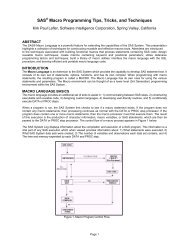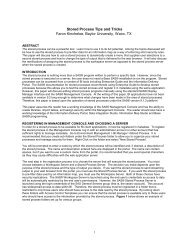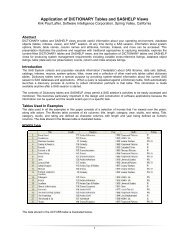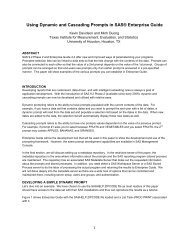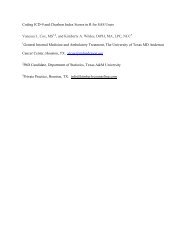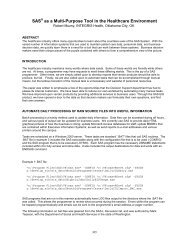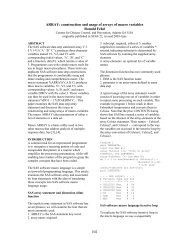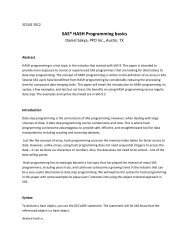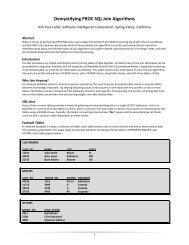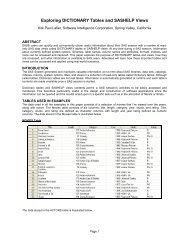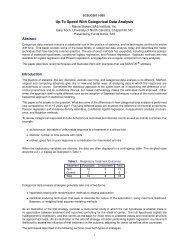Risk-Based Portfolio Optimization Using SAS Wei Chen, SAS ...
Risk-Based Portfolio Optimization Using SAS Wei Chen, SAS ...
Risk-Based Portfolio Optimization Using SAS Wei Chen, SAS ...
Create successful ePaper yourself
Turn your PDF publications into a flip-book with our unique Google optimized e-Paper software.
<strong>Risk</strong>-<strong>Based</strong> <strong>Portfolio</strong> <strong>Optimization</strong> <strong>Using</strong> <strong>SAS</strong> ®<br />
<strong>Wei</strong> <strong>Chen</strong>, <strong>SAS</strong> Institute Inc., Cary, NC<br />
ABSTRACT<br />
In the midst of the recent turbulence in financial markets, risk management has become an increasingly critical part of<br />
the decision-making process in financial institutions. A risk-based profitability strategy helps increase firm value and<br />
helps avoid costs associated with financial distress. This paper explains how advanced risk analysis and optimization<br />
products from <strong>SAS</strong>® can work together to enable optimal, risk-adjusted portfolio decisions. Several portfolio<br />
optimization problems are discussed: (1) maximization of portfolio return subject to a target risk tolerance, expressed<br />
as standard risk measures such as value at risk (VaR); (2) minimization of asset/liability mismatch through cash flow<br />
allocation minimization; and (3) minimization of capital requirements by employment of an optimal risk mitigation<br />
strategy. For these problems, best-practice solutions are presented using <strong>SAS</strong> <strong>Risk</strong> Management solutions.<br />
INTRODUCTION<br />
Modern financial theory has supported a strong relationship between profitability and risk. <strong>Risk</strong> borne by an<br />
investment should be compensated by excess return. Financial institutions such as banks are known to take the risk<br />
intermediation function for the entire economy. Adequate recognition of the underlying risk of an investment strategy<br />
is a critical part of a financial decision process. Markowitz (1952) introduced the seminal risk-based portfolio<br />
optimization model, which won him the 1990 Nobel Prize for Economics, together with William Sharpe and Merton<br />
Miller. (All three laureates were awarded the Nobel Prize for their work in risk-based decision theories in investment<br />
and corporate finance.)<br />
The past few decades have seen tremendous advances in financial markets. The innovations of financial products<br />
and financial management tools have contributed many good aspects to economic development. The complication in<br />
the financial market has made both researchers and practitioners realize the limitation of the normality assumption in<br />
the earlier work of the risk portfolio theory. In the early 1990s, J. P. Morgan proposed a new risk measure, value at<br />
risk (VaR), which is a possible loss or value at a certain confidence interval. Statistically, VaR is simply a percentile<br />
of a distribution. It extends the standard deviation to a measure that does not restrict its application to the normal<br />
distribution. Other risk measures have been proposed as alternatives to standard deviation and VaR in the last<br />
decade. Artzner et al. (1997) summarized the fundamental properties of a coherent risk measure. <strong>Based</strong> on these<br />
new risk measures, the Basel committee proposed two international regulatory capital requirements in 1988 and<br />
2004, known as Basel I and Basel II (Basel Committee 1988 and Basel Committee 2004). Following suit, the<br />
European Commission has recently published the new, risk-based capital requirement framework known as Solvency<br />
II (European Commission 2008) for insurance companies. With the emergence of the new risk measures and riskbased<br />
capital requirement, Markowitz’s risk-based portfolio optimization framework can be extended to robust forms.<br />
The technique of portfolio optimization is not only useful for portfolio selection, it is also useful in areas like asset<br />
pricing, collateral allocation, and asset liability management. The basic idea is to apply risk measures in an optimal<br />
decision process.<br />
Three categories of single-stage optimization approaches are typically seen for portfolios with stochastic nature: (1)<br />
reduced form—risk statistics for example standard deviation, risk weights are estimated separately from the<br />
optimization problem; (2) stochastic programming—risk is explicitly modeled in an optimization process; and (3)<br />
simulation-based optimization—optimization over a simulated sample space that turns stochastic programming into a<br />
deterministic programming problem. This paper presents several implementations of risk-based portfolio optimization<br />
using <strong>SAS</strong> <strong>Risk</strong> Management solutions that leverage <strong>SAS</strong> risk computation and optimization procedures. With the<br />
strong portfolio simulation power in <strong>SAS</strong> <strong>Risk</strong> Management solutions, all of the optimizations covered in this paper<br />
have an approach. “A Brief Review of <strong>Risk</strong> Measures” explains a few risk measures and portfolio optimization<br />
business cases. “<strong>Portfolio</strong> <strong>Optimization</strong>” introduces portfolio optimization that is used in portfolio selection. “Asset<br />
Liability Management with Stochastic Cash Flow” extends portfolio optimization to a cash-flow-based decision<br />
environment. “Optimal Credit <strong>Risk</strong> Mitigant Allocation” introduces an innovative optimal credit risk mitigant allocation<br />
algorithm in a credit risk portfolio under the new Basel II regulatory capital requirement framework. “Conclusion”<br />
concludes the paper.<br />
A BRIEF REVIEW OF RISK MEASURES<br />
For two portfolios—X and Y—Artzner et al. (1997) prescribed the following conditions for a risk measure m to be<br />
COHERENT:<br />
1
• Subadditivity – m X + Y ≤ m X + m(Y): diversification is good for a portfolio.<br />
• Homogeneity – m tX = tm X for any constant t: no scale effect on a portfolio risk.<br />
• Monotonicity – m(X) ≥ m(Y) if X>Y almost surely: risk is duely reflected in the risk measure.<br />
• Translation invariance – m X + r = m X + r: risk-free asset does not contribute to overall risk.<br />
Coherence of a risk measure is important for many reasons. Subadditivity and monotonicity together implies<br />
convexity, which is a necessary condition for the existence of a global optimum. A well-known result documented by<br />
Artzner et al. (1997) is that the widely accepted VaR measure introduced below is not guaranteed to be a coherent<br />
risk measure unless the underlying risk distribution belongs to an elliptic family.<br />
The following risk measures are widely used in financial risk management:<br />
<br />
Standard Deviation: It is mostly used as a statistical measure to describe the volatility of random variables.<br />
In a nonparametric setting, the measure is defined as:<br />
σ = E[X − E X ] 2 ,<br />
where E stands for the expectation of a random variable. In practice, people use the standard error from a<br />
sample space as an estimator of the standard deviation.<br />
The standard deviation captures the randomness of a normally distributed risk variable. It is also a<br />
coherence risk measure for most of the early work of the modern finance theory, including Markowitz’s<br />
portfolio optimization, Sharpe (1964)’s capital asset pricing model (CAPM), and Black and Scholes (1973)’s<br />
option pricing formula. Only for elliptic-distributed underlying risk volatility, VaR , and expected shortfall are<br />
all equivalent because of the scalability of these distributions. For example, for normal distribution, VaR is<br />
simply a multiple of the standard deviation, where the multiplier is the corresponding percentile on a<br />
standard normal distribution.<br />
<br />
VaR: It has been a widely used measure in risk management since its birth. In simple business terms, it<br />
represents the maximum value or loss at a given confidence interval. Mathematically, it is defined as:<br />
VaR α = inf[x|P(X ≥ x) ≥ α],<br />
where α is the given confidence interval. It is usually estimated in the same way as a percentile of a<br />
distribution for the given confidence interval α.<br />
VaR works for all distribution assumptions and provides intuitive business justification. As a result, it is used<br />
by many financial institutions despite its unwarranted coherence in general.<br />
<br />
Expected Shortfall (or Conditional VaR): It is a coherent risk measure. By definition, it is:<br />
ES α = E[X|X ≥ VaR α ]<br />
where VaR α is the VaR previously defined. For a fat tail distribution, expected shortfall is not guaranteed<br />
to exist. If it exists, it represents the expected value or loss beyond a given confidence interval. For a given<br />
sample space, expected shortfall is estimated as the mean of the points beyond and including VaR of a<br />
confidence interval α. This conditional mean calculation requires caution to remain convex.<br />
<strong>SAS</strong> <strong>Risk</strong> Management solutions compute these risk measures and their variations using standard statistical<br />
algorithms.<br />
An important application of these risk measures is to calibrate a financial institution’s capital requirement. Such<br />
capital is a financial institution’s own funds that are set aside to protect the institution from insolvency from big losses.<br />
This capital is oftentimes required to cover projected unexpected loss of a given confidence interval, which makes a<br />
connection to the risk measures. For example, the Basel II capital requirement for banks is based on 99% VaR for<br />
market risk (internal model approach) and 99.9% VaR for credit risk.<br />
PORTFOLIO OPTIMIZATION<br />
<strong>Portfolio</strong> optimization has wide applications in portfolio asset allocation and asset pricing. The traditional portfolio<br />
optimization is mean-variance optimization, which was originated by Markowitz (1952). The decision rule is to<br />
maximize the expected return of the portfolio, while keeping the return variance to a certain level. (Or to minimize the<br />
2
eturn variance for a given expected return.) The resulting portfolios for different desired variance levels make a socalled<br />
mean-variance efficient frontier. Mean-variance optimization led to the birth of CAPM, which was introduced<br />
by Sharpe (1964). In the following sections, mean-variance, mean-expected-shortfall (mean-ES), and mean-value-atrisk<br />
(mean-VaR) optimizations (supported in the <strong>SAS</strong> <strong>Risk</strong> Dimensions OPTIMIZATON statement) are explained.<br />
MEAN-VARIANCE OPTIMIZATION<br />
Let θ = (θ 1 , … , θ M ) be a vector of random returns of M assets in a portfolio.<br />
Let x = (x 1 , … , x M )′ be a vector of the percentage of the portfolio invested in these assets.<br />
The expected returns vector is θ. The covariance matrix of returns on these M assets is Q. The mean-variance<br />
optimization seeks to find an optimal vector x such that:<br />
(1) max x x′θ<br />
is subject to:<br />
x ′ Qx ≤ δ 2<br />
M<br />
i=1<br />
x i = 1<br />
lb ≤ x ≤ ub,<br />
where δ 2 is a preset tolerance of the variance of portfolio return, lb and ub are vectors of the lower and upper bounds<br />
of percentage weight on the assets in the portfolio. A user can also add linear business constraints (for example,<br />
weights on fixed-income assets in the portfolio retained at a certain level).<br />
The optimal solutions to (1) from a range of δ 2 constraints result in a mean-variance efficient frontier. An example of<br />
the mean-variance efficient frontier created by <strong>SAS</strong> <strong>Risk</strong> Dimensions for a sample portfolio is illustrated in figure 1. It<br />
shows a portfolio of fixed incomes, derivatives, and equities based on a historical simulation over monthly interest<br />
rates, foreign exchange rates, and equity prices data from August 1998 to August 2001. The range of volatility<br />
constraint is (0, 0.03).<br />
Figure 1. Mean-Variance Efficient Frontier of a <strong>Portfolio</strong> in an Historical Simulation<br />
MEAN-ES AND MEAN-VAR OPTIMIZATIONS<br />
Because of the limitation on volatility, mean-VaR optimization is becoming more popular in portfolio optimization.<br />
Both VaR and expected shortfalls are related to set of percentiles on a return distribution. Because expected shortfall<br />
is a convex risk measure, it is more amenable for global optimization than VaR and volatility. Let’s assume a<br />
3
confidence interval α for the expected shortfall for the return distribution with density function p ∙ , which warrants a<br />
finite expected return of the portfolio. (The analytical presentation turns out to be unimportant for the optimization<br />
problem). Following the definition of expected shortfall and using the same notations as in (1), expected shortfall can<br />
be expressed as the conditional expectation of the portfolio return associated with choice of asset weights x can be<br />
expected as:<br />
(2) φ α x, γ = γ + 1<br />
−x ′ θ − γ + p θ dθ,<br />
1−α<br />
where γ is the smallest 1 solution to:<br />
ω x, γ = I( − x′θ ≤ γ) p θ dθ = α, [y] + y, y > 0<br />
= {<br />
0, y ≤ 0<br />
and I z = {1,<br />
if z is true<br />
0, otherwise .<br />
Rockafellar and Uryasev (2000) proved that (2) is a convex and continuously differentiable function. They show that<br />
in a sample space of N, simulated samples from the distribution of θ, can be further approximated by a convex (in<br />
x, γ) and piecewise linear (in γ) function:<br />
φ α x, γ = γ + 1 N<br />
−x ′ θ j − γ +<br />
(1−α)N j=1<br />
Therefore, given a simulation with N scenarios, a mean-ES 2 optimization is equivalent to finding the solution for:<br />
(3) min (x,γ) γ + 1 N z j<br />
(1−α)N j =1<br />
which is subject to:<br />
x′θ ≥ μ<br />
z j ≥ 0<br />
x ′ θ j + γ + z j ≥ 0, for j = 1, … , K<br />
M<br />
i=1<br />
x i = 1<br />
lb ≤ x ≤ ub,<br />
where μ is the preset target of mean return, and z j are the auxiliary variables that are derived from the simulated<br />
distribution of N simulated scenarios.<br />
Similar to (1), linear business constraints can be added to (3) as well. <strong>Based</strong> on the above idea, <strong>SAS</strong> <strong>Risk</strong><br />
Dimensions uses a scenario-based approach that converts a stochastic optimization into a deterministic optimization<br />
with simulated scenarios.<br />
A mean-VaR optimization can be expressed as the following:<br />
(4) min x [V α,N (−x ′ θ 1 , … , −x ′ θ N )]<br />
which is subject to:<br />
x′θ ≥ μ<br />
M<br />
i=1<br />
x i = 1<br />
lb ≤ x ≤ ub.<br />
VaR is not a convex risk measure for most of the non-elliptic distributions, so (4) might not warrant a well-behaved<br />
optimization problem. However, Rockafellar and Uryasev (2000) have shown that from the presentation of the mean-<br />
ES problem (3), it can be seen that γ is a lower bound to the VaR at confidence interval α. Therefore, one can<br />
iteratively minimize (3) with respect to γ to approach the optimal solution of (4). On the other hand, a brute force<br />
nonlinear optimization using PROC NLP is also accommodated in <strong>SAS</strong> <strong>Risk</strong> Dimensions.<br />
VaR and expected shortfall minimization might not always be a well-posed problem, even if the convexity is satisfied.<br />
Alexander et al. (2004) gave an example of an ill-posed optimization problem for a derivative portfolio where<br />
derivatives are evaluated with the delta-gamma approximation. The linear programming of an expected-shortfallbased<br />
approach becomes inefficient for a large portfolio in this case.<br />
1 Equation ω x, γ = α might contain more than one solution, although ω x, γ is a continuous and non-decreasing function.<br />
2 Krokhmal et al. (2002) showed that the mean-ES optimization in (3) generates the same efficient frontier as maximizing the<br />
mean return subject to a preset tolerance of expected shortfall using the same auxiliary variable representation. Both<br />
optimizations are supported in <strong>SAS</strong> <strong>Risk</strong> Dimensions.<br />
4
More information about the implementation of the previous problems can be found in the documentation of the<br />
OPTIMIZATION statement in <strong>SAS</strong> <strong>Risk</strong> Dimensions.<br />
ASSET LIABILITY MANAGEMENT WITH STOCHASTIC CASH FLOW<br />
Figure 2. Sample Asset Liability Gap for a Range of Time Buckets<br />
The previous optimization cases were based on the market value of the positions in a financial institution’s portfolio.<br />
A lot of financial business is cash-flow-based. As market intermediator, a bank typically borrows from and lends to<br />
different finance sources and makes a profit from the process. A pension fund must produce income cash flow from<br />
5
its investments to support its payout commitment. Similarly, an insurance company relies on income from its assets<br />
and fees to cover its liabilities. For any institution with outstanding debts, enough cash flow from future business<br />
operations is critical for the institution to keep a good credit status. In these cases, decisions have to be made based<br />
on future cash flows generated from a portfolio of assets and liabilities. Ziemba (2003) has more details about the<br />
optimization for asset liability management.<br />
Cash flows from positions in a portfolio can happen on different dates and be of different amounts. To simplify the<br />
cash flow analysis, financial institutions usually group cash flows into a set of predefined time buckets in the future.<br />
The choice of time buckets is specific to each institution’s business strategy and operational life cycle. The bucketed<br />
cash flows are compared by asset and liability. Any significant gaps between the two might call for an alternate<br />
business strategy. There are many ways that gaps can be constructed. For example, one can compare the<br />
scheduled single or accumulated cash flow amounts in each bucket to look for a potential liquidity problem, or one<br />
can check the cash flows that are subject to rate adjustment (repricing) in future time periods, or one can compare<br />
durations and convexities (both are sensitivity measures) of the cash flows. For a portfolio of fixed incomes and<br />
derivatives across regions of London, New York, and Tokyo, figure 2 shows a portion of the cash flow gap report<br />
produced by <strong>SAS</strong> <strong>Risk</strong> Dimensions and <strong>SAS</strong> <strong>Risk</strong> Management for Banking.<br />
<strong>SAS</strong> <strong>Risk</strong> Management for Banking enables the user to leverage the strong cash flow analysis of PROC RISK and<br />
the flexible optimization modeling of PROC OPTMODEL to accomplish decision objectives for asset and liability<br />
management. The process involves the following steps:<br />
1. Simulate market states based on user-specified simulation methods (model-based, historical, or scenario).<br />
2. Generate cash flows of user-defined types (maturity, repricing, interest income, and so on) for each<br />
simulated market state and collect them into buckets.<br />
3. Analyze the bucketed cash flows by assets and liabilities (at each additional user-defined reporting<br />
hierarchy).<br />
4. Execute optimization based on a selected objective function and constraints for the cash flows.<br />
This process is driven by data in <strong>SAS</strong> <strong>Risk</strong> Dimensions.<br />
In general, the following optimization problem yields an institution’s asset allocation strategy to minimize the gap<br />
between its asset and liability by maturity.<br />
(5) min wt<br />
f [ <br />
xA<br />
tT<br />
n<br />
k1 iA,<br />
jL<br />
k k<br />
( xiCt, i<br />
Ct,<br />
j<br />
)]<br />
Where:<br />
A = a set of all instruments of which the positions can be adjusted.<br />
L = a set of all fixed positions.<br />
n = the number of simulated scenarios.<br />
T = a set of time buckets.<br />
x i = the number of shares of a particular asset instrument.<br />
C t,i = the cash flow from either an asset or liability in time bucket t in a simulated scenario. Cash<br />
flows from liability carry negative signs.<br />
w t = the weight of a time bucket.<br />
f ∙ the function that is determined by the decision rule.<br />
This problem is subject to business constraints or risk (for example, VaR) constraints. Additional constraints might<br />
include x i ≥ 0 if short-selling assets are not allowed. For the performance of the optimization, usually x i ’s are not<br />
restricted to integers. In most cases, the function f(∙) is chosen as the least square or absolute function.<br />
Equation (5) is a single-stage optimal portfolio allocation. A multi-stage problem would require dynamic portfolio<br />
rebalance over the life of the decision process. Multi-stage optimization might be possible with a dynamic trading and<br />
reinvestment feature that will soon be available in <strong>SAS</strong> <strong>Risk</strong> Dimensions.<br />
A replicating portfolio has its roots in derivative pricing. The idea is to price a portfolio of illiquid assets with a set of<br />
liquid assets that have tangible market values. The liquid assets must be able to replicate the cash flow streams of<br />
the illiquid assets in all possible market scenarios. The recent birth of fair value rules has made the replicating<br />
portfolio approach more important. For example, the Solvency II framework for European insurance and reinsurance<br />
institutions has required the replicating portfolio technique to get the values of the insurance liabilities on the balance<br />
sheet. The objective function for the replicating portfolio can be similar to the minimization problem (5), where<br />
present values replace the straight values of all cash flows. That is, instead of C k t,i , the present value cash flow<br />
6
discounted in the corresponding simulated scenario d k k<br />
t C t,i is applied. <strong>Risk</strong> constraints like variance, expected<br />
shortfall, and VaR can be applied to (5), which leads to a more risk-based replication. In the replicating portfolio<br />
application, assets have to be chosen to represent the unique features in the underlying liability structure, including<br />
optionality and payoff conditions. This topic is beyond the scope of this paper.<br />
OPTIMAL CREDIT RISK MITIGANT ALLOCATION<br />
Credit risk is one of the most significant risks a financial institution encounters every day. In general, credit risk is the<br />
risk of loss induced by the failure of a counterparty to fulfill the contracted obligation. Financial institutions have<br />
traditionally leveraged several tools such as guarantees, credit derivatives, collateral, or netting agreements to<br />
mitigate losses due to credit risk. The well-specified credit mitigation tools are often recognized in the capital<br />
requirement calculation. For example, Basel II has required the following:<br />
<br />
<br />
<br />
Credit exposures must be risk-weighted based on their credit qualities.<br />
If an eligible credit risk mitigant is present with an exposure, then the risk weight of the credit risk mitigant<br />
can be used as the risk weight of the portion of the exposure that is covered by the credit risk mitigant.<br />
The applicable value of the credit risk mitigant must be adjusted based on the nature of the mitigant.<br />
Because an excessive capital level takes away an institution’s business development opportunity, it is to the benefit<br />
of the institution to reduce its capital.<br />
<strong>SAS</strong> introduced an optimal credit risk allocation method in its <strong>SAS</strong> Credit <strong>Risk</strong> Management for Banking solution<br />
using the generalized network algorithm. Before the method is described, consider the concept of a generalized<br />
network.<br />
GENERALIZED NETWORK FOR AN EXPOSURE AND MITIGANT RELATION<br />
Networks arise in numerous settings and in a variety of guises. Operations research has seen rapid advances in the<br />
methodology and application of network optimization models. A network representation provides a powerful visual<br />
and conceptual aid for portraying the relationships between the credit exposures and the credit risk mitigants. The<br />
generalized network optimization model in this context poses a special type of linear programming problem that can<br />
efficiently be solved with millions of exposures and mitigants that are in most banks.<br />
Here are a few mathematical terms of the network models:<br />
<br />
<br />
<br />
<br />
<br />
Node is an entity in the network usually labeled as suppliers, demanders, or transition.<br />
Arc is the path from one entity to another.<br />
Directed network is a network that has only directed arcs.<br />
Arc cost is the cost associated with an arc when goods are moved from one end of the arc to the other.<br />
Arc multiplier is the discount factor associated with an arc when goods move through it.<br />
Figure 3 is a directed network representation of an exposure and mitigant network. There are three exposures—E1,<br />
E2, and E3—and four credit risk mitigants—C1, C2, C3, and C4. The node NC supplies all of the unsecured portions<br />
of the exposures in the diagram. The credit risk mitigants act as supply nodes and exposures act as demand nodes.<br />
The flow costs are simply the risk weights associated with the mitigants. The arcs reflect the contractual relations<br />
between credit risk mitigants and exposures. In figure 3, exposure E1 is secured by C1 and C2, E2 is secured by C3<br />
only, and E3 is secured by C3 and C4. Any amount flowed out of the NC node takes the risk weight of the<br />
correspondent exposure. The first number on each arc (exposure-mitigant relation) indicates the cost (risk weight)<br />
associated with the arc.<br />
To adjust for the potential changes in the material value of the credit risk mitigants, additional adjustments are<br />
required based on the nature of the mitigants. For example, Basel II has required haircut discounts to financial<br />
collaterals and nettings. In addition, if the exposures and credit risk mitigants are in different currencies, further<br />
haircut discounts are required for the fluctuation of the foreign exchange rate dynamics. Because the discount might<br />
depend on both the exposure and the credit risk mitigant, it is arc dependent. <strong>Using</strong> the generalized network model,<br />
discounts can be added to the arc to represent the attrition in the goods. The second number on each arc indicates<br />
the multiplier associated with the arc.<br />
7
E1<br />
0, 0.7<br />
C1<br />
[70]<br />
50%, 1<br />
[100]<br />
200%, 1<br />
C2<br />
[60]<br />
E2<br />
0, 0.8<br />
C3<br />
[110]<br />
300%, 1<br />
[100]<br />
0, 0.7<br />
75%, 0.8<br />
C4<br />
E3<br />
250%, 1<br />
[150]<br />
[200]<br />
NC<br />
Figure 3. Example of an Exposure Mitigant Network<br />
OBJECTIVE FUNCTION<br />
The regulatory credit risk capital requirement proposed by Basel II can be summarized as the computation of the<br />
aggregated risk-weighted assets (which are a regulatory approximation of the VaR (previously introduced)):<br />
(6)<br />
RWA EAD RW i i<br />
1<br />
n<br />
i<br />
RWA stands for risk-weighted asset, EAD stands for exposure at default, and RW is the risk weight. The total<br />
number of exposures is n. When credit risk mitigants are present with an exposure, the exposure can be<br />
decomposed into an unsecured portion and several secured portions that take the adjusted value of the credit risk<br />
mitigant. The secured portions take the risk weights that correspond to the mitigants. (<strong>Risk</strong> weight for a credit risk<br />
mitigant does not necessarily have the same interpretation as the risk weight for an exposure, but it has a similar<br />
effect.) The unsecured portion takes the risk weight of the exposure itself. The risk-weighted asset in equation (6)<br />
can now be written as:<br />
(7)<br />
n<br />
m<br />
RWA ( SEC<br />
i1 j 1<br />
i<br />
i<br />
j<br />
i<br />
RW<br />
j<br />
i<br />
USEC<br />
RW )<br />
i<br />
i<br />
SEC is the secured portion and USEC is the unsecured portion. Each exposure can be secured by several credit risk<br />
mitigants. In general, multiple exposures covered by multiple credit risk mitigants should be considered in the<br />
methodology description.<br />
With the introduction of the arc multiplier, the regulatory capital is related to the following equation:<br />
n mi<br />
(8)<br />
RWA ( SEC RW M USEC<br />
RW )<br />
<br />
i1 j 1<br />
i<br />
j<br />
i<br />
j<br />
i<br />
j<br />
i<br />
i<br />
i<br />
8
The optimal credit risk mitigant allocation for the objective function in the Basel II specification becomes a minimum<br />
cost network flow problem with cost function (8).<br />
The previous optimal credit risk mitigant allocation can be implemented using the<br />
CRM_ALLOCATION_METHOD=”OPTIMAL” option in <strong>SAS</strong> Credit <strong>Risk</strong> Management.<br />
AN EXAMPLE<br />
Figure 3 further illustrates the problem and the proposed solution.<br />
The Problem<br />
A bank has three loan exposures—E1 through E3—and four credit risk mitigants—C1 through C4. Here is the<br />
detailed information.<br />
1. E1 has EAD $100 and is risk-weighted 200%. E2 has EAD $110 and is risk-weighted 300%. E3 has EAD<br />
$200 and is risk-weighted 250%.<br />
2. C1 and C3 are financial collaterals, C2 is a guarantee, and C4 is a receivable. C1 is worth $70. C2 is worth<br />
$60 and is risk-weighted 50%. C3 is worth $100. C4 is worth $150 and is risk-weighted 75%.<br />
3. The directed arcs in figure 3 represent the possible coverage between the credit risk mitigants and<br />
exposures. They are typically specified by the business contracts and cannot be altered.<br />
Financial collaterals are usually subject to haircut adjustments (collateral itself, and a currency mismatch adjustment,<br />
if necessary). Let’s assume the haircut adjustments result in multipliers as (E1, C1)=0.7, (E2, C3)=0.8, and (E3,<br />
C3)=0.7. The guarantee has no adjustment, so the multiplier on (E1, C2)=1. The receivable is subject to an overcollateralization<br />
adjustment, which results in the multiplier (E3, C4)=0.8.<br />
The regulatory capital requirement requires the risk-weighted asset to be calculated as equation (8). In addition, the<br />
bank needs to report the risk weight for the secured and unsecured portions of each exposure.<br />
The Solution<br />
In this simple example, there are a few ways that the bank can apply the credit risk mitigants to the exposures.<br />
1. For E1, there are two possible ways to apply the mitigants.<br />
a. Apply C1 first and C2 second.<br />
The secured portion by C1 is $49 with 0 risk weight. The secured portion by C2 is $51 with 50%<br />
risk weight. The RWA for E1 is $25.50 (49*0+51*50%=25.5).<br />
b. Apply C2 first and C1 second.<br />
The secured portion by C2 is $60 with risk weight 50%. The secured portion by C1 is $40 with 0<br />
risk weight. The RWA for E1 is $30 (60*50%+40*0=30).<br />
2. E2 and E3 share C3, but E4 has sole claim to C4. There are two possible ways to apply the mitigants.<br />
a. E2 is secured by C3 and E3 is secured by C4.<br />
The secured portion of E2 by C3 is $80 with 0 risk weight. The unsecured portion is $30 with 300%<br />
risk weight. The RWA for E2 is $90 (80*0+30*300%=90).<br />
The secured portion of E3 by C4 is $120 with 75% risk weight. The unsecured portion is $80 with<br />
250% risk weight. The RWA for E3 is $290 (120*75%+80*250%=290).<br />
The total RWA for E2 and E3 is $380.<br />
b. E3 is secured by C3 and C4. E2 is completely unsecured.<br />
The secured portion of E3 by C3 is $70 with risk weight 0. The secured portion of E3 by C4 is $120<br />
with risk weight 75%, which leaves $10 unsecured. The RWA for E3 is $185<br />
(70*0+120*75%+10*250%=185). The RWA for E2 unsecured is $330 (110*300%=330).<br />
The total RWA for E2 and E3 is $515.<br />
Overall, there are four possible ways to apply the credit risk mitigants in this example. The optimal solution is the 1(a)<br />
and 2(a) combination, where the total RWA is $405.5. The worst solution is the 1(b) and 2(b) combination, where the<br />
total RWA is $545. For a bank with millions of exposures and credit risk mitigants, each worth hundreds of thousands<br />
of dollars, the differences in the RWA because of mitigant allocations can be drastic. Having an optimal solution is<br />
not trivial. <strong>SAS</strong> Credit <strong>Risk</strong> Management uses PROC OPTLP to solve this problem.<br />
Because exposures and credit risk mitigants only form a closed network when they are related on the contractual<br />
base, the minimal cost network optimization technique can be applied to each independent sub-network without<br />
sacrificing the global optimum. In the above example, (E1, C1, C2) and (E2, E3, C3, C4) are two disjointed networks.<br />
9
A network partition algorithm, based on the contractual relations between exposures and mitigants, is used in <strong>SAS</strong><br />
Credit <strong>Risk</strong> Management to recognize all of the sub-networks.<br />
A point worth making is that the optimal allocation might not always be allowed if a business contract clearly states<br />
how credit risk mitigants should be applied. <strong>SAS</strong> Credit <strong>Risk</strong> Management provides users with an option to honor the<br />
contractual allocation, instead of the optimal allocation. Even if this is the case, the optimal allocation is still useful for<br />
decision makers to get more insightful information on how risk can be reduced in an alternative way.<br />
The generalized network approach to the optimal credit risk mitigant allocation provides an intuitive and efficient<br />
algorithm to allocate exposures and credit risk mitigants to minimize credit risk. The objective function can be<br />
extended beyond the Basel II capital requirement. When the problem extends with simulated scenarios, the variance,<br />
VaR, and expected shortfall optimization techniques can be applied.<br />
CONCLUSION<br />
<strong>Risk</strong>-based portfolio optimization supports better financial decision making on a risk-adjusted basis. In a fluctuating<br />
financial market, a risk-based decision process becomes more essential for a financial institution. This paper<br />
presents several portfolio optimization methods in <strong>SAS</strong> <strong>Risk</strong> Management solutions that use risk modeling, analysis,<br />
and optimization. These methods have many applications beyond financial portfolios. In a case where a decision<br />
can be modeled with uncertainty (for example, a real option problem), a risk-based portfolio optimization can help<br />
reach an intuitive result.<br />
<strong>SAS</strong> <strong>Risk</strong> Management solutions strive to provide cutting edge solutions for decision making in a risk environment.<br />
REFERENCES<br />
Alexander, S., T. F. Coleman, and Y. Li. 2004, “Minimizing VaR and CvaR for a <strong>Portfolio</strong> of Derivatives.” Working<br />
Paper, Cornell University, 2004.<br />
Artzner, P., F. Delbaen, J. M. Eber, and D. Heath. 1997. “Coherent Measures of <strong>Risk</strong>.” Mathematical Finance 9:203-<br />
228.<br />
Black, F., and M. S. Scholes. 1973. “The Pricing of Options and Corporate Liabilities.” Journal of Political Economy<br />
81(3):637-654.<br />
Krokhmal, P., J. Palmquist, and S. Uryasev. 2002. “<strong>Portfolio</strong> <strong>Optimization</strong> with Conditional Value-at-<strong>Risk</strong> Objective<br />
and Constraints.” Journal of <strong>Risk</strong> 4(2):43-68.<br />
Markowitz, H. M. 1952. “<strong>Portfolio</strong> Selection.” Journal of Finance 7:77-99.<br />
Rockafellar, R.T., and S. Uryasev. 2000. “<strong>Optimization</strong> of Conditional Value-at-<strong>Risk</strong>.” Journal of <strong>Risk</strong> 2(3):21-39.<br />
Sharpe, W. F. 1964. “Capital asset prices: A theory of market equilibrium under conditions of risk.” Journal of Finance<br />
19:425-442.<br />
Ziemba, W.T. 2003. The Stochastic Programming Approach to Asset, Liability, and Wealth Management. Research<br />
Foundation of CFA Institute.<br />
RESOURCES<br />
Basel Committee. 1988. International convergence of capital measurement and capital standards. Available at<br />
http://www.bis.org/publ/bcbs04a.htm.<br />
Basel Committee. 2004. Basel II: International Convergence of Capital Measurement and Capital Standards: a<br />
Revised Framework. Available at http://www.bis.org/publ/bcbs107.htm.<br />
Commission of the European Communities. 2008. Amended Proposal for a Directive of the European Parliament and<br />
of the Council on the taking-up and pursuit of the business of Insurance and Reinsurance - (Solvency II). Available at<br />
http://ec.europa.eu/internal_market/insurance/solvency/index_en.htm#proposal.<br />
ACKNOWLEDGMENTS<br />
The author is grateful to Donald Erdman and Jimmy Skoglund for their comments and suggestions.<br />
10
CONTACT INFORMATION<br />
Your comments and questions are valued and encouraged. Contact the author at:<br />
<strong>Wei</strong> <strong>Chen</strong><br />
<strong>SAS</strong> Institute Inc.<br />
<strong>SAS</strong> Campus Drive<br />
Cary, NC 27513<br />
E-mail: wei.chen@sas.com<br />
<strong>SAS</strong> and all other <strong>SAS</strong> Institute Inc. product or service names are registered trademarks or trademarks of <strong>SAS</strong><br />
Institute Inc. in the USA and other countries. ® indicates USA registration.<br />
Other brand and product names are trademarks of their respective companies.<br />
11



